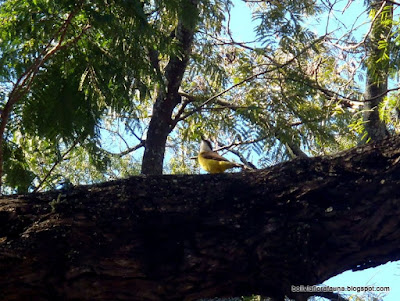The thing about birds is that what may appear exotic and rare depends on your perspective. We spent a morning in Coimata, just 20 minutes from Tarija by vehicle. The area has plant covered cliffs and beautiful cascading falls. We enjoyed seeing the native flora and fauna up close. Then, as we are leaving the park, we hear a loud, unusual bird call. We look around quickly and finally spot a large bird in a tree. Due to the distance and the shaded light only one shot came out good enough to see details. Here’s what we got.
The bird in the center has his back to us and head turned to the right. We were really excited about this rare sighting and when we got home we carefully examined
our illustrated guide book to find out what kind of exotic bird we had just seen. At first we thought it was the Boat-billed Flycatcher, but then realized that bird may be similar but what we had seen was the Great Kiskadee of the family of Tyrants – New World Flycatchers. How exciting! But the first detail in the guide’s description brought us back to reality: “extremely common almost everywhere.” Its range of habitat takes it from southern Texas all the way through Central America and down into South America to the middle of Argentina. Yep. Not a ‘rare sighting’. Since that first encounter, we have seen and heard them everywhere. Here’s one in a playground in Tarija:
I’m not sure why it took six months of living in Bolivia before we first spotted the Great Kiskadee. Perhaps because everything was so new to us that it just blended into the landscape. At any rate it is a beautiful bird. Here are some more shots we got of one directly overhead in a plaza in Santa Cruz.
The thick black bill is as long as the head. The head and face are black with a concealed yellow crown-patch and a strong white band around from the forehead.
The throat is white and the breast and belly are yellow. The upperparts and wings are brownish-green, but the wings and tail usually have strong cinnamon fringes.
But why did I say earlier that we have now seen and heard them everywhere? Their call is loud and seems to be saying: “Kisk – ka – DEEEEE!” Below is a video we filmed of one perched in a tree where you can hear the call. If you listen carefully (volume turned all the way up) you will hear other Kiskadees responding.
(Please note: to watch the video again click on the circular arrow on the bottom left of the box. After our video plays, YouTube may advertise related videos from other people.)
One of the Spanish names for the Kiskadee is ‘Bienteveo’ which means ‘I see you well’. One of our Tarijan friends told us the bird is saying “Bien – te – FUE”. Which means “It went well for you.” And of course each country has some legend about what they think the bird is saying. Just in case you speak Czech you would call it ‘Tyran bentevi.’
So is it a rare and exotic bird? Well, what’s your opinion? Are they in your area? Is it common to you or rare? Leave a comment below to share your thoughts. As for me, my perspective has changed. It was rare and exotic to me when I first saw it, but several months have passed since then. So although I still turn to find the source of each screeching call I hear, now I just smile and think ‘There’s another one, and it sees me too.’
Now for the details:
- Family: Tyrannidae
- Latin name: Pitangus sulphuratus
- Size: 22cm (8.75 inches)
- Voice: Loud “weh... weh... wehhhh...” with variations, often dueted.
- Common names:
- English: Great Kiskadee
- South American: Benteveo (Argentina, Bolivia, Chile); Féo o Cristofué (Bolivia); Pitogüe (Paraguay); Benteveo común (Argentina, Uruguay); Bem-te-vi o Bem-te-vi-de-coroa (Brazil).






No comments:
Post a Comment